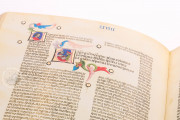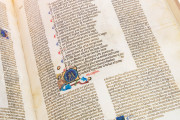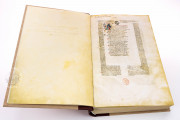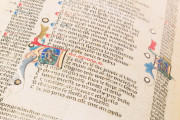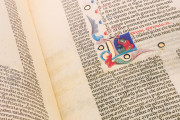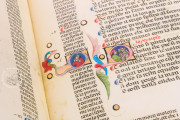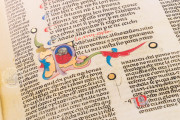The Florence-Milan Manuscript of Dante Alighieri's Divine Comedy is the earliest manuscript to include the commentary of Jacopo della Lana—the first exposition that treats the whole poem. Copied in the Veneto in the second quarter of the fourteenth century, it is also among the earliest manuscripts of Dante's masterpiece. The illumination sets it apart from all other early manuscripts of the poem. Its 199 historiated initials generally do not depict the scenes described by Dante but instead—in Inferno and Purgatorio—the transgressions that would lead to the torments described by the poet.
Dante's Christian moralizing poem describes the poet's journey, identified as having taken place in 1300, through nine circles of hell (in Inferno); seven terraces where souls purge themselves (in Purgatorio); and then into the earthly paradise, through the nine heavenly spheres and, finally, into the Empyrean (in Paradiso).
Father and Son Collaboration
Galvano da Bologna wrote the text of the Florence-Milan Manuscript, including the rubrics, in his Bolognese version of Gothic Rotunda. He systematically corrected the text, and he may have been the illuminator of Paradiso. Galvano's son, Tommaso, is known to have been an illuminator, and he may be responsible for the initials in Inferno and Purgatorio.
Few Figures Convey Clear Messages
The manuscript's historiated initials are small, with subjects involving just one or two figures. The initials of Inferno and Purgatorio are often very lively, nonetheless. The avaricious man illustrating Purgatorio, canto 20, is shown not just clutching a money bag but running away from a beggar as he does so, his body almost entirely outside the body of the letter C (Florence, fol. 149r).
The initial P for Inferno, canto 14, shows a blasphemer with sheathed sword and spear gesturing with a long finger pointed at the head of Christ (Florence, fol. 39r). The initial P for Purgatorio, canto 7, illustrates that souls can be rescued: Christ carrying the banner of Resurrection breaks the gates of Limbo and frees a soul (Florence, fol. 118v).
A Layout Reminiscent of Legal Manuscripts
Jacopo della Lana's commentary presented a new problem for the page design of the Commedia. Galvano presents Dante's text in the center of each page with della Lana's commentary surrounding it in two columns, a page layout typical of the law books that were Galvano's stock-in-trade in the production of manuscripts for students at the university in Bologna.
Through Inferno and Purgatorio, Galvano custom-designed each opening of facing pages to accommodate Dante's poem and the corresponding section of Lana's commentary without leaving any blank spaces. In Paradiso, however, keeping the two texts coordinated resulted in more blank parchment; perhaps a lack of patience or time led to less careful planning.
Three Volumes into Two
The manuscript was originally in three volumes, one for each canticle of Dante's long poem—Inferno, Purgatorio, and Paradiso. The first two volumes were probably bound together in the early eighteenth century. They appear as a single volume in the 1756 inventory of the library of the Riccardi family (foundation collection of Biblioteca Riccardiana). The Paradiso was in the collection of the Benedictine monastery of Santa Giustina in Padua by the early eighteenth century.
We have 1 facsimile edition of the manuscript "Divine Comedy - Florence-Milan Manuscript": Il Manoscritto Riccardiano-Braidense della Commedia di Dante Alighieri facsimile edition, published by Salerno Editrice, 2007
Request Info / Price


